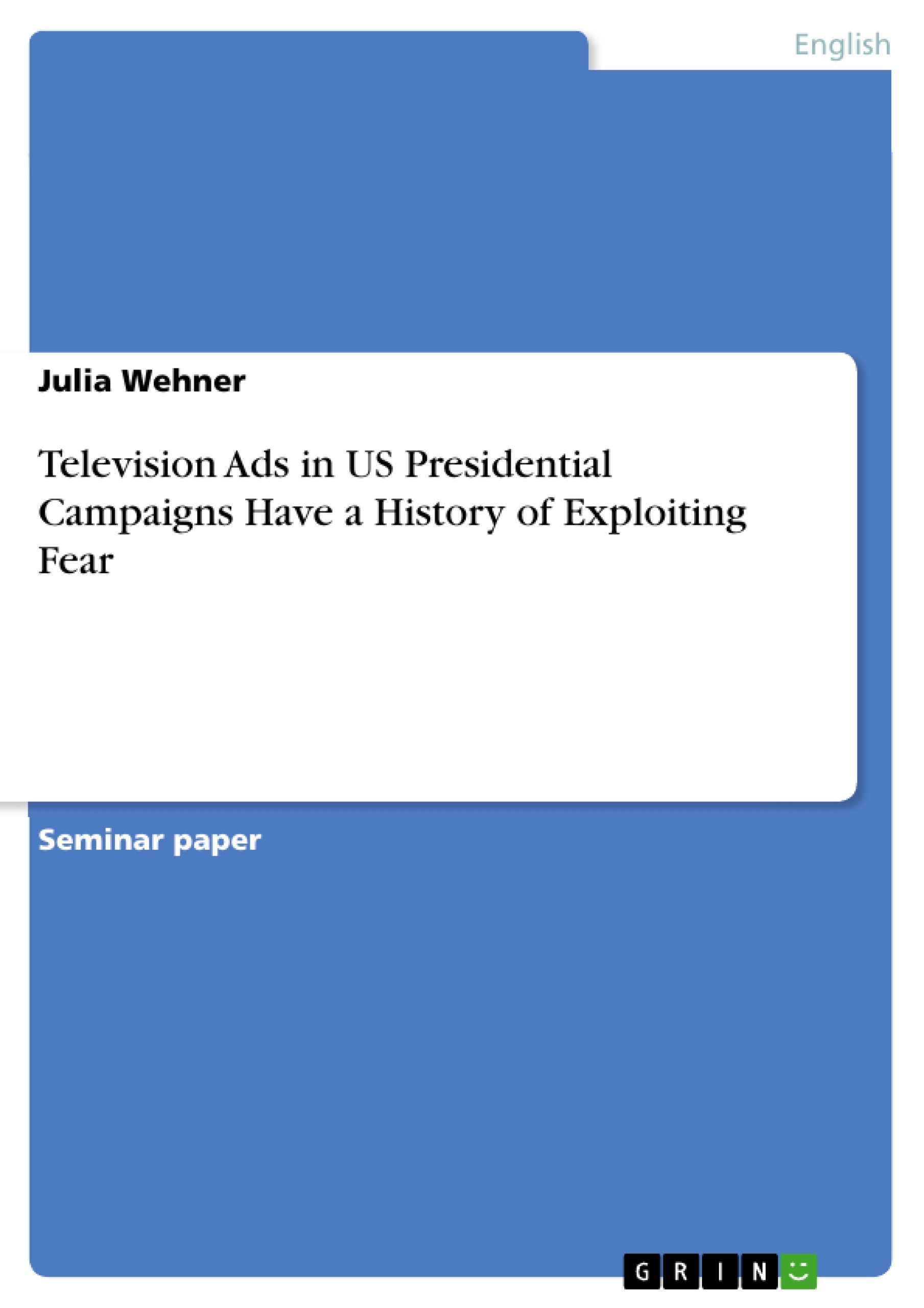Election campaigns are common rituals in democracies.
Politicians try to persuade voters in order to be elected.
Therefore, political candidates usually make use of professional
campaigning strategies that involve the television as the most
important medium. Since the 1960s US presidential campaign
ads on TV have been increasingly successful and cutting-edge.
They sometimes were so convincing they even swung a
decision. Over the last decades the predominant topics in US
federal politics were the Cold War as well as national security
and the US military. In 1964 the presidential election campaign
was highly influenced by the escalating situation in Vietnam and
the general disquiet caused by the arms race and nuclear
weapons. The American psyche was collectively anxious about
the latent atomic menace so it suggested itself to address fear
in a presidential campaign ad. The Nixon campaign 1972 dealt
with one of the genuine Republican topics: Military. Due to its
success it was remade in two subsequent campaigns called
“Tank Ride” in 1988 for George Bush and 2004 in “Weapons
Florida” for George W. Bush. The latter will be examined in this
paper, too.
However, there are different approaches to persuade the
voting public; one of the most favorable techniques is playing
on the people’s emotions. Thus, it is not surprising that US
presidential campaign ads have a history of exploiting fear in
television ads. It leads from 1964 until 2004 and aims at
persuading voters by the well-directed use of sounds, images
and language.
Inhaltsverzeichnis (Table of Contents)
- Introduction
- "Peace Little Girl (Daisy)", 1964 (Johnson)
- Images
- Sounds
- Language
- "McGovern Defense", 1972 (Nixon)
- Images
- Sounds
- Language
- "Weapons (Florida)", 2004 (George W. Bush)
- Images
- Sounds
- Language
- Conclusion
- Works Cited
Zielsetzung und Themenschwerpunkte (Objectives and Key Themes)
This paper explores the history of fear exploitation in US presidential campaign television advertisements, analyzing three pivotal examples: the "Peace Little Girl (Daisy)" ad from the 1964 Johnson campaign, the "McGovern Defense" ad from the 1972 Nixon campaign, and the "Weapons (Florida)" ad from the 2004 George W. Bush campaign. The paper examines the use of imagery, sound, and language in these ads to effectively evoke fear in the voting public.
- The impact of fear on voter behavior in US presidential elections
- The use of visual and auditory techniques to elicit fear responses
- The role of language in reinforcing fear-based messaging
- The effectiveness of fear appeals in influencing voter decisions
- The historical context of Cold War anxieties and national security concerns in US politics
Zusammenfassung der Kapitel (Chapter Summaries)
- The introduction provides context for the study, highlighting the common use of television advertising in US presidential campaigns. It specifically addresses the prominence of Cold War anxieties, national security, and the US military in shaping the political landscape during the analyzed period (1964-2004).
- Chapter 2 focuses on the iconic "Peace Little Girl (Daisy)" ad from the 1964 Johnson campaign. The chapter delves into the ad's visual composition, sound design, and language, demonstrating how each element effectively contributes to the fear-inducing message.
- Chapter 3 analyzes the "McGovern Defense" ad from the 1972 Nixon campaign, examining its visual, auditory, and linguistic strategies in similar detail as the previous chapter. The chapter explores how this ad plays on a different set of fears relevant to the political climate of the time.
- Chapter 4 examines the "Weapons (Florida)" ad from the 2004 George W. Bush campaign, continuing the pattern of analysis established in previous chapters. This chapter investigates how the ad uses fear to connect with a contemporary audience in the post-9/11 era.
Schlüsselwörter (Keywords)
This paper focuses on the key concepts of fear, political advertising, television media, US presidential elections, visual rhetoric, auditory rhetoric, language, Cold War, national security, military, and voter behavior. The analysis delves into the effectiveness of fear appeals in influencing voters, exploring the specific strategies employed by political campaigns to evoke and manipulate fear.
- Quote paper
- Julia Wehner (Author), 2011, Television Ads in US Presidential Campaigns Have a History of Exploiting Fear , Munich, GRIN Verlag, https://www.grin.com/document/189939



